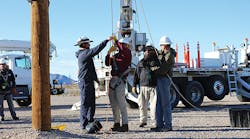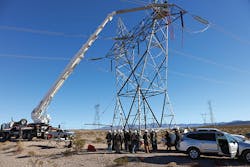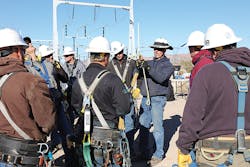Crews Learn to Work Live While Using Fall Protection
Linemen worked barehand on an energized 345-kV line during a training session in Flagstaff, Arizona. Although it wasn’t the first time that Western Area Power Administration (WAPA) had offered the training, it marked the first time crews performed energized training while 100% attached.
Crews from WAPA’s Desert Southwest region participated in barehand and hot-stick training that incorporated the latest 100% fall-protection requirements set by Occupational Safety and Health Administration (OSHA). Prior to the training
session, WAPA provided instruction at the Mead substation. But when crews completed the training, the new OSHA requirements were not yet in effect.
“We had to create new procedures because of the new equipment and how things have changed since the new requirements,” said Shayne Bender, an Upper Great Plains lineman and fall-protection specialist. “This is the fourth time we’ve done this training but our first time using the new fall-protection methods.”
Working Barehand
Trainers demonstrated hot-stick methods to train linemen how to complete maintenance on energized transmission lines and equipment. And less than a mile down the road, crews were conducting another training — barehanding a live 345-kV wire.
During barehand work, linemen are protected by wearing a mesh-wire suit and grounded to a bucket truck. While in the basket of the bucket truck, linemen are lifted toward the energized wire, and they hold up a metal rod, called a bonding wand, to start the flow of electricity at the highest point. Once the rod touches the line, crews in the basket are safe to touch the live wire as the current then flows through the suit to the ground, eliminating risk of electrocution.
During the training, trainers used gas-powered trolleys, called spacer carts, to travel freely down the line while performing maintenance. Linemen power the carts using a foot pedal.
“The fall-protection community is developing new procedures to rescue crews off fiberglass ladders and spacer carts,” Bender says. “These processes are new at WAPA, and it is exciting to implement our new fall-protection measures.”
Developing New Techniques
The training session gave the linemen the chance to practice barehand in a variety of new scenarios and learn how to use the equipment properly while attached. “With the new requirements, linemen have to operate differently than they are used to,” says Horacio Adriano, a lineman from the Desert Southwest region.
In addition to the WAPA crews, other linemen also participated in the training session. Salt River Project, a WAPA customer in Phoenix, Arizona, sent three linemen to be trained alongside WAPA crews to practice the new training methods.
“They heard about what we were doing for fall protection,” said Dave Katich, a Desert Southwest lineman and fall-protection specialist. “They came to check out our best practices while working in a live environment.”
WAPA also brought in Jim McDonald, a 40-year industry veteran and owner of Powerline Training Consultants, to assist with the training.
“From what I have seen in the industry so far, WAPA is much more advanced and more technical in its fall-protection methods; they are taking a proactive approach with all their gear and equipment,” McDonald says.
By using state-of-the art equipment and techniques, WAPA is demonstrating its commitment to safety. Adding the opportunity to train in a live environment ensures crews will have the tools, knowledge and training to do their work in the safest manner possible.
Training on Fall Protection
Prior to the recent barehand training, WAPA also offered train-the-foreman and train-the-trainer fall-protection training near Boulder City, Nevada. With OSHA’s standard of 100% attachment requirement in place, craft foremen, trainers and WAPA leadership created solutions to exceed standards and to provide even safer working environments for employees. The one-month training focused on fall-protection leadership.
Headquarters Safety and Occupational Health Manager Patrick Nies said WAPA wanted to provide foremen with a better understanding of fall-protection policies and more skills to problem solve fall-protection issues on the job. By bringing everyone together, it helped to give a consistent message, Bender says.
Consistent messaging is important not only to maintaining mission effectiveness, but to giving foremen one voice to conduct their jobs safely. Rocky Mountain lineman and fall-protection specialist Jason Wientjes says the training allowed the crews to give a unified and consistent approach to all of its training across WAPA.
The training covered fall-protection concepts and rescue techniques using new equipment on both wood and steel structures. Trainers provided crews hands-on experience with new equipment and proper methods for rescue techniques. They simulated falls with 150-lb to 300-lb dummies, using real-world scenarios and weights of workers including gear.
The new equipment includes two different Y-lanyards developed specifically for WAPA crews and a compressed air line-launcher in conjunction with a power-descender. “With both of those tools, we are able to ascend the tower, without having to worry about step bolts or anchor points,” Katich says.
Inside the substation, 23 foremen and five supervisory electricians practiced fall-protection methods on a training transformer, simulating a fall at-height. Through their training, they have implemented a guard rail system that allows crews to work above 6 ft without attachments, speeding up the process and allowing crews to work unattached and without obstructions.
“The training was a huge success in the eyes of the fall-protection committee,” said Bob Conklin, a Desert Southwest electrician foreman and fall-protection specialist. “The foremen were engaged during the training and provided useful feedback, which indicated that they left with more clear understanding of the fall-protection program and process.”
Overall, the new training methods were a success, and crews expressed their satisfaction with providing a single training in one location. “Everyone was really engaged and proactive during the training,” said Sierra Nevada Lineman Ryan Mumma. “Crews are looking forward to applying these practices in the field.”
Travis Weger is a public affairs specialist for Western Area Power Administration.




